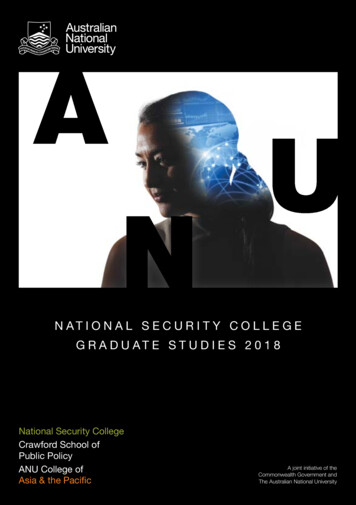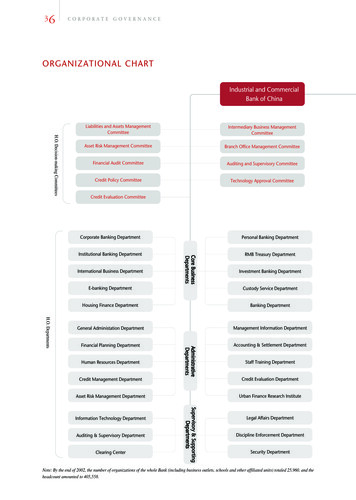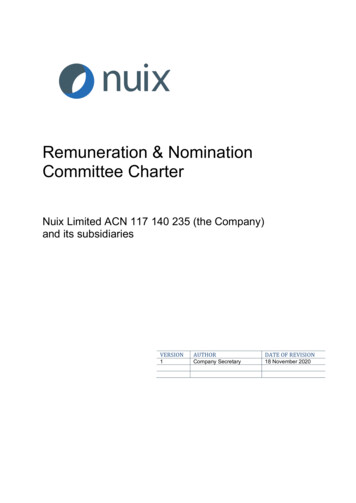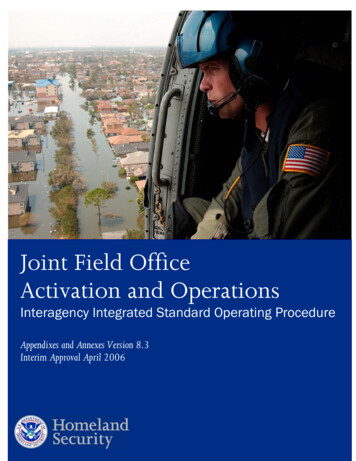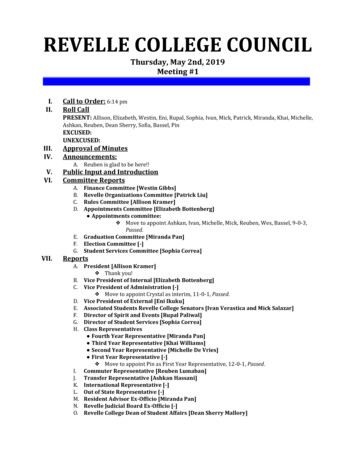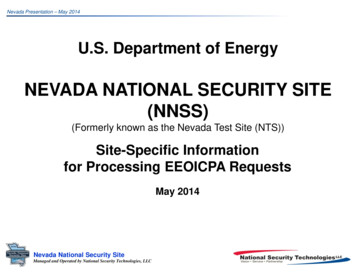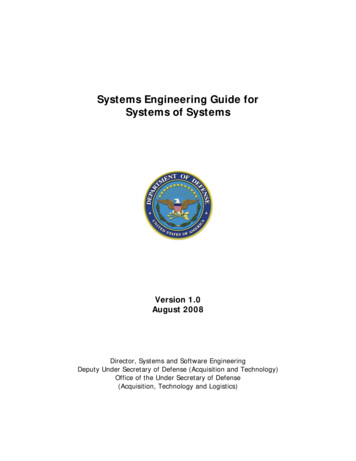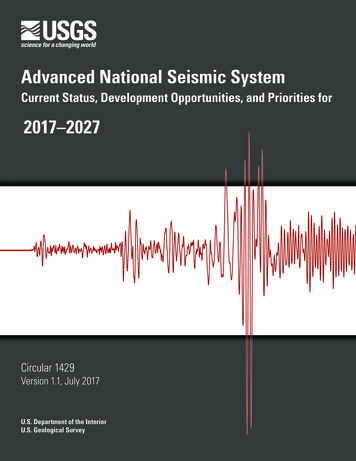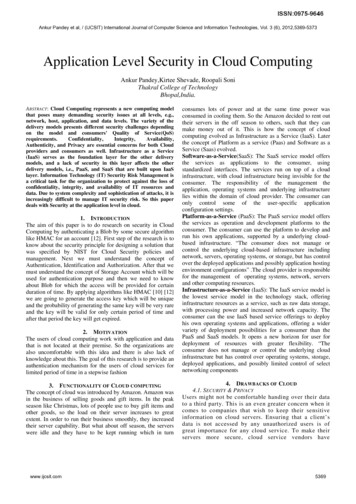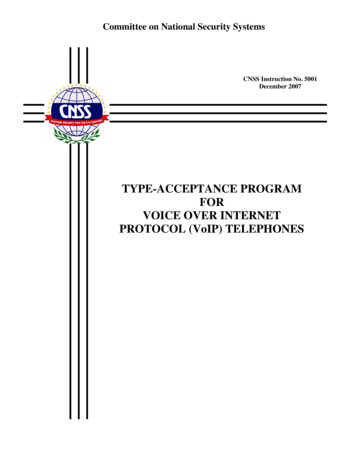
Transcription
Committee on National Security SystemsCNSS Instruction No. 5001December 2007TYPE-ACCEPTANCE PROGRAMFORVOICE OVER INTERNETPROTOCOL (VoIP) TELEPHONES
Committee on National Security SystemsCNSS Instruction No. 5001National ManagerFOREWORD1. The Committee on National Security Systems Instruction (CNSSI) No. 5001,“Type-Acceptance Program for Voice over Internet Protocol (VoIP) Telephones,”specifies the design, construction, connectivity criteria, acceptance procedures,manufacturer’s testing requirements, and documentation for VoIP type-acceptedtelephones.2. The National Telecommunications Security (NTS) Working Group (WG),formerly known as the Telecommunications Security Group (TSG), is the primarytechnical and policy resource in the U.S. Intelligence Community (IC) for all aspects ofthe Technical Surveillance Countermeasures (TSCM) Program involving telephonesystems located in areas where sensitive government information is discussed.3. TSG Standards will be replaced by and issued as CNSS Instructions (CNSSIs).Director Central Intelligence Directive (DCID) No. 6/9, reference a, delineated TSGStandards and Information Series compliance by Sensitive Compartmented InformationFacilities (SCIFs) for the protection of sensitive information and unclassifiedtelecommunications information processing systems and equipment; SCIF complianceshall now be fulfilled in accordance with the appropriate CNSSIs.4. CNSS Instruction No. 5001 is effective upon receipt.5. Copies of this instruction may be obtained by contacting the Secretariat at410.854.6805 or www.cnss.gov.6. U.S. Government contractors and vendors shall contact their appropriategovernment agency or Contracting Officer Representative regarding distribution of thisdocument.//s//KEITH B. ALEXANDERLieutenant General, U.S. ArmyCNSS Secretariat (I922) / National Security Agency9800 Savage Road - Suite 6716 - Ft Meade MD 20755-6716Office: (410) 854-6805 / Unclassified FAX: (410) 854-6814cnss@radium.ncsc.mil
CNSS Instruction No. 5001TYPE-ACCEPTANCE PROGRAMFORVOICE OVER INTERNET PROTOCOL (VOIP) SWG TYPE-ACCEPTANCE PROGRAMPROCEDURE FOR OBTAINING AND MAINTAINING NTSWGTYPE-ACCEPTANCEDESIGN AND CONSTRUCTION REQUIREMENTSSUPPLEMENTARY DESIGN AND CONSTRUCTIONSPECIFICATIONS IVIIIIXSECTION I – PURPOSE1. This instruction specifies the design, construction, connectivity criteria,acceptance procedures, manufacturer’s testing requirements, and documentation for VoIPtype-accepted telephones for use in any U.S. Government or government contractorsensitive area where national security systems (NSS) are employed and/or withinenvironments where national security information (NSI) is stored, processed, ortransmitted. The requirements established in this instruction are intended to ensure thatcompliant devices cannot pass any audio via VoIP telephones and/or systems located insensitive discussion areas when they are in an idle state (i.e., not an active call).SECTION II – SCOPE2. The provisions of this instruction apply to all VoIP Telephony Systems thatcurrently reside, or will reside, in U.S. Government or U.S. Government sponsoredcontractor spaces where NSS are employed and/or within environments where classifiedNSI is stored, processed, transmitted, or when used as a point of isolation in accordancewith reference b.3. This instruction shall be referenced and included in U.S. Government-sponsoredprocurement specifications to define NTSWG VoIP type-accepted telephones.-2-
CNSS Instruction No. 50014.This instruction shall be made available to telephone manufacturers who aresupporting U.S. Government contractual requirements for NTSWG VoIP type-acceptedtelephones.SECTION III – REFERENCES5.References are listed in ANNEX A.SECTION IV – DEFINTIONS6.Definitions in CNSSI No. 4009, reference c, apply to this policy; additionalpolicy-specific terms are defined in ANNEX B.SECTION V – NTSWG TYPE-ACCEPTANCE PROGRAM7.The NTSWG type-acceptance program’s objective is to assure the on-hookaudio security of all telephone equipment residing in sensitive discussion areas of theU.S. Government or U.S. Government sponsored contractor spaces. The program isdedicated to developing and coordinating the security measures to prevent, detect, andcorrect on-hook audio anomalies within the telephone equipment.8.The NTSWG strives to assure that, for any situation, the appropriate authoritiesof each U.S. Government department or agency will always be able to select and adapt themost appropriate means to effectively and economically obtain the necessary level ofsecurity.9.References b and d through g provide general and specific information applicableto this program.10. The NTSWG recognizes that not all situations require the same level of security.A measure that is completely proper and sufficient for some applications could beinadequate for other applications; however, the appropriate level of security for anyspecific application may generally be achieved with a selected combination of severalmeasures. The cumulative effect of properly selected complementary measures (whichwould have been deficient individually) can be used to produce the desired result.Accordingly, every telephone-related security problem of which NTSWG is made awareis examined in detail so the government may be provided with the greatest possiblediversity of approaches for its correction.11. A viable and important approach for telephone security, which has long beenemployed by the U.S. Government, is the concept of the type-accepted telephone. This is-3-
CNSS Instruction No. 5001a telephone instrument, which by virtue of its design and construction has the followingproperties:11.1 The telephone cannot be caused to produce audio when it is in the idlestate except by intrusive physical modifications within the telephone set.11.2 The telephone is not tractable to the implementation of intrusivemodifications.11.3 Electrical and physical inspection can readily determine if an intrusivemodification has been placed within the telephone and if the design/construction securitymeasures are operating properly.11.4 The VoIP telephone communicates with the voice network over apublicly published protocol, or if the protocol is proprietary it must be provided to theNTSWG prior to instrument testing.12. Reference e specifies the design and construction criteria for the NTSWGtype-acceptance of telephones that are compatible with the traditional non-proprietarycentral office interface of the public switched telephone network (PSTN). A fundamentalrequirement of the basic NTSWG type-accepted telephone is for all external wirelinesentering the telephone be disconnected from all internal circuitry (except the annunciator)when the telephone is in the idle state. VoIP telephones, even when they are in the idlestate, need continuous connectivity to a VoIP system in order to exchange information ona regular basis. Therefore, the VoIP system cannot support the requirement for totalphysical disconnect from the external wirelines. The NTSWG type-acceptancerequirements to be applied for telephones using Internet protocol (IP) to carry voice areprovided by this instruction vice reference e.13. Without the use of type-accepted telephones, telephone installations can beconsidered secure only if the telephones are isolated or disconnected from all unprotectedwires, which is achieved by the means of supplementary isolator or disconnect devicesplaced on the wires or by using a Computerized Telephone System (CTS) speciallyconfigured to conform to reference b.14. On-hook telephone security based on isolation or disconnect methods cannot beuniversally applied to VoIP telephones as:14.1 VoIP telephones are not compatible with conventionalisolator/disconnect devices that are designed for the normal central office interface. Itmay be possible to construct a VoIP line isolator that would remove base-band audiofrom the wires, but such an isolator would not prevent network access to the idletelephone.-4-
CNSS Instruction No. 500114.2 Results of system characteristics or operational constraints, someinstallations, and some VoIP telephones in particular, physically cannot be made toconform to this instruction. Also, in many cases the cost of applying this instruction isincommensurate with the number of telephones that must be protected. Even thoughthere may only be a few specific telephones in the installation that require on-hooksecurity, the entire system would have to comply with the instruction.15. The type-acceptance of VoIP telephones that have been demonstrated toincorporate intrinsic on-hook audio security provides a means to assure the security of aninstallation when isolation/disconnection measures (supplementary devices and/or theexisting TSG/NTSWG installation guidelines) are either physically incompatible oreconomically infeasible.16. Neither the type-acceptance program nor the application ofisolation/disconnection measures method is regarded as being better than the other. Theyare both equally acceptable alternative methods for obtaining audio security. There willbe situations where either the isolation/disconnection approach or the type-acceptedtelephones will be the preferred method.17. The following elements of the NTSWG telephone type-acceptance program areessential:17.1 The design and construction specifications that describe the conditionsunder which telephones are considered to be:17.1.1 Physically incapable (by reason of design and construction) ofproducing microphonic audio on any wires leaving the instrument while it is in the idlestate.17.1.2 Capable of being individually subjected to routine on-sitephysical and electrical inspections.17.2 The standardized evaluation and qualification conditions that are used todetermine each type-acceptance class.17.3 The requirements for documentation and sureties to be provided to therequesting U.S. Government department or agency. These must properly demonstrateand guarantee that a particular model telephone does conform to all required criteria.Any telephone model whose design and construction is shown by adequatedocumentation, backed by the necessary surety, to conform to the required criteria will betype-accepted by the NTSWG and approved for installation and use without anyrequirement for additional isolation or disconnect measures.17.4The type-acceptance application process.-5-
CNSS Instruction No. 500117.5 Limited requirements on product stability. These are applied, for themost part, only to those components of the type-accepted telephone that are used toimplement mandatory security features. The manufacturer is largely free to change allnon-related areas without affecting its type-acceptance status.17.6Labeling requirements for type-accepted telephones.17.7 Guidelines for use by U.S. Government departments and agencies toenable them to identify and select telephones suitable for use in sensitive discussionareas.18. Type-acceptance programs are mutually beneficial to the government and to thetelephone industry. The NTSWG design and construction criteria for type-acceptance areprovided both to U.S. Government departments and agencies and members of thetelephone industry. The identification of the type-accepted telephone models allowsgovernment departments and agencies (who are concerned about on-hook telephonesecurity) to exclude from consideration for procurement all telephones that are notacceptable. Manufacturers who wish to compete in this market can readily determine iftheir products are acceptable and, if not, what modifications are necessary to make thetelephones acceptable. The type-acceptance procedure clearly defines what portions ofthe telephone can be subsequently altered by the manufacturer without affecting itstype-accepted status. Changes of this sort can be made at the discretion of themanufacturer without involvement of the government.19. In order that maximum flexibility is provided to produce the most economical,fully effective security program for every individual application, NTSWG has developedcriteria for multiple categories of type-accepted electronic telephones.20. The intent of the NTSWG type-acceptance program is for all telephones to bephysically incapable of producing any microphonic audio on any wires leaving theinstrument while it is in the idle state.21. For this instruction, two classes rate the telephone equipment on the basis ofidle-state security only. In-use security considerations are of importance in somesituations, and manufacturers may wish to indicate special virtues of their products thatare applicable to those situations. Class A equipment is not dependent on any otherequipment for security. Class B equipment meets the same testing criteria as Class Aequipment with the exception of testing in the power off state. The power off test is oneof the most difficult for the equipment to pass. Class B equipment must be directlyconnected to a network switching device collocated within the same sensitive area as thetelephone.-6-
CNSS Instruction No. 5001SECTION VI – PROCEDURE FOR OBTAINING AND MAINTAINING NTSWGTYPE-ACCEPTANCE22. Type-acceptance procedures cannot be applied effectively to any telephonewithout the full cooperation of the manufacturer. The type-acceptance model involvesthe manufacturer on a continuing basis, to include, but not be limited to the following:22.122.2requirements.Design of the original telephone.Design of modifications necessary to comply with the type-acceptance22.3 Testing the candidate telephone to establish that it does perform inaccordance with the type-acceptance criteria.22.4requirements.Documentation of all claims relating to the type-acceptance22.5procedures.Technical information to support the development of field inspection23. When a manufacturer applies for and receives type-acceptance, it is for thespecific configuration described in the application documentation. NTSWG assigns atype-acceptance number to the submitted configuration, which cannot be used on anyalternative configuration that involves a change to any portion of the telephonedesignated as a critical subassembly/security feature for the type-acceptance class. Themanufacturer’s type-acceptance may be revoked, at any time, when evident that thetelephone is not providing adequate idle-state audio security.INITIAL CONTACT24. A manufacturer responding to a specific procurement requirement (whether adirect request or a public announcement) of a U.S. Government department or agencysubmits the application for type-acceptance to the specific U.S. Government departmentor agency.25. A manufacturer wishing to obtain type-acceptance to gain entry into the portionof the government market affected by the type-acceptance program can apply to anyparticipating U.S. Government department or agency.PROCEDURE26.Sponsor ascertains the type-acceptance class/classes required, if appropriate.-7-
CNSS Instruction No. 500127. NTSWG evaluates the proposed products to determine the degree of compliancewith the criteria for the class intended.28. The vendor develops and implements any modifications necessary to meet therequisite criteria. Documentation of the proposed modifications may be submitted to theU.S. Government department or agency in question for preliminary evaluation beforeactual implementation. [Preliminary approval of the approach, based on thedocumentation submitted, means only that no obvious deficiencies are in evidence.Actual type-acceptance requires that the modified telephone be fully tested in accordancewith the requirements for the type-acceptance class in question. There is no assurancethat an approach that has received preliminary approval will pass these tests.]29. Vendor submits letter of application, signed by an authorized company official,containing the following:29.1 Identification of product includes the manufacturer, product line, andmodels involved and additional descriptive information, as necessary, to eliminate allpossibility of ambiguity or confusion with any other product.29.2The class for which application is being made.29.3 Certification that the product meets the criteria for that class, and that itmay be opened for visual and electrical inspection (to verify that it conforms to alltype-acceptance criteria) at any time without invalidating the normal product warranties.Note: This requirement does not apply to Type 1 encryption equipment.29.4 Point of contact for inquiries must include: name, title, address,telephone number, and email.30. Vendor submits summary of product offering, including manufacturer's salesand/or technical literature for the product.31. Vendor submits their own summary of test results, explaining basis for assertingthat the proposed telephone meets the appropriate type-acceptance criteria.32.Vendor submits functional description, containing the following:32.1Operation of telephone.32.2Appearance.32.3Installation requirements.32.4Operations manual.-8-
CNSS Instruction No. 500132.5Identification of all systems with which the telephone is compatible.32.6 Features, options, and auxiliary units available with the version beingevaluated. Options available on the standard commercial model may, at themanufacturer's discretion, be excluded from the version being submitted fortype-acceptance.33.Vendor submits electrical description, containing the following:33.1 Theory of operation, including description of connection to VoIP systemand any other external connections.33.2 Block diagrams, including complete descriptions of signals betweenfunctional blocks.33.3Schematic diagrams and circuit descriptions.33.4Components listing.33.5Installation and maintenance manual(s).34. Vendor submits detailed security evaluation that includes all features, options,and auxiliary units included in paragraph 32.6. All applicable criteria are applied to thebasic telephone and to the composite formed when the auxiliary units are attached andoperational, that includes:34.1 Providing component layout diagrams, including location and functionof test points.34.2 Providing circuit descriptions and diagrams of all audio circuits, focalsubassemblies, and critical subassemblies.34.3 Identifying all components (manufacturer and model number) added toimplement positive security measures.34.4 Documenting operational behaviors of software/firmware involved inthe implementation of the positive security measures.34.5 Citing each applicable type-acceptance criterion by its paragraphnumber in Section VII of this instruction (the paragraph numbers indicate if the criterionbeing addressed is specific to the class that the application is being requested). Showhow the proposed telephone complies with the criterion.35. NTSWG will coordinate laboratory testing on sample product. The laboratorytest report will typically have a limited distribution to U. S. Government personnel andcontain the following information:-9-
CNSS Instruction No. 500135.1Abstract.35.2Objectives of tests.35.3List of test equipment used.35.4Test equipment configuration used for each test.35.5Test data and conclusions.36. Vendor will provide support documentation for field tests and inspections fordistribution to field inspection teams for use during on-site testing. The informationprovided for this purpose should be non-proprietary to include:36.1Component layout diagrams, including location and function of any test36.2Instructions for assembly and disassembly of the telephone.points.36.3assemblies.Photographs showing the appearance of all circuit boards and37. Supplementary information may be requested by the U.S. Government in orderto complete the U.S. Government evaluation of the application.MARKETING OF TYPE-ACCEPTED TELEPHONES38. Telephones being marketed to U.S. Government departments or agencies, asNTSWG type-accepted telephones must be permanently marked with the NTSWGtype-acceptance number and either the serial number or the month and year ofmanufacture. Additionally, if the instrument is speakerphone capable the label mustindicate that fact.39. A NTSWG type-acceptance number assigned to a telephone will be recognizedas a type-accepted item by all U.S. Government departments and agencies without needfor further evaluation.- 10 -
CNSS Instruction No. 5001SECTION VII – DESIGN AND CONSTRUCTION REQUIREMENTSPreliminary NoteThe general approach and requirements applicable to all type-acceptance classes arepresented here.INTRODUCTION40. The criteria used to determine qualification for type-acceptance in one of thedesignated security classes apply to VoIP type-accepted electronic telephones. There areonly two classes: Class A equipment is not dependant on any other equipment for security. Class B equipment meets the same testing criteria as Class A equipmentwith the exception of testing in the power off state. The power off test is one of the mostdifficult for the equipment to pass. Class B equipment must be directly connected to anetwork switching device that is physically located in the secure area and controlled.41. The telephone must be demonstrably physically incapable of producing anymicrophonic audio on any wires leaving the instrument while it is not in use.42. Regardless of the state of the telephone (e.g., in-use, idle, programming ), nochange (i.e., temporary or permanent) in any of the security features required for thetype-acceptance class can result from any acoustic or electromagnetic signals, or fromaction by the parent system, or from signals on any of the station mounting cord wires orpower supply wires. The security features are independent of the voltages (or absencethereof) on any of the wires.43. All transducers shall be physically isolated from all external wiring. A visualindicator shall be illuminated at all times when any physical isolation is not active. Thisvisual indicator shall only be controlled through the physical act of either taking theinstrument off hook, or activating approved speakerphone function. These controls shallbe impervious to firmware or software manipulation.44. NTSWG has concluded that in most cases the objectives of this program arebest achieved by using metallic-contact disconnect devices (switches and relays). It isrecognized that the modern telephone industry often regards these devices as obsoletetechnology. The requirement herein, however, does not derive merely from thefunctional performance, but from physical and electrical characteristics that make theperformance readily confirmable by electrical and physical inspection. It is emphasized,therefore, that whenever the type-acceptance criteria specifically designatesmetallic-contact disconnect devices, functionally equivalent operational alternativesemploying more modern technologies will not be acceptable. The metallic-contactdisconnect devices used to isolate and short the various transducers and handset functionsmay be switches located in the handset mounting that are operated directly by placing and- 11 -
CNSS Instruction No. 5001removing the handset, or they may be relays that are controlled by whatever form ofhookswitch is used.OPERATIONAL LIMITATIONS45. The telephone must not be capable of cordless operation. Wireline connectionsbetween the telephone and the VoIP system are needed for the telephone to function. Allcommunications and information interchange among the telephone, the component parts,auxiliary units, and the VoIP system must be over physical connections.46. There must not be any hands-free answering capability. A manual action on thepart of the user is necessary to initiate, answer, join, or maintain a call. The telephonecan be in the in-use state only if:46.1The handset is physically removed from the handset mounting, or46.2A manual speakerphone switch is activated, or46.3An auxiliary unit is manually activated, or46.4 A type 1 device running in secure data-only mode may have an autoanswer function.47. Some telephones may require additional action by the user (such as pressing aline select key) to be in the in-use state, which is entirely acceptable.48.The telephone is immediately restored to and remains in the idle state if:48.1All auxiliary units are manually deactivated, and48.2All speakerphone switches are turned off, and48.3The handset is positioned in the handset mounting.49. When a call termination is verified, all required idle-state security measuresautomatically and immediately become effective. When the telephone is in the idle-statethe telephone shall be designed to prevent the codec from passing audio electricallyoutside of the telephone assembly.50. Security measures that require manual action cannot include anysoftware-dependent or firmware-dependent functions.51. The hold feature is required for in-use state. When the user activates the holdfeature, no audio from the line placed on hold may be transmitted outside of thetelephone assembly and handset.- 12 -
CNSS Instruction No. 5001TELEPHONE SECURITY INSPECTION SUPPORT MEASURESElectrical Requirements52. In implementing the design criteria the telephone is to be treated as an ensembleof electrical and electronic subassemblies, some of which contain microphoniccomponents. Evaluation with respect to security principles and the implementation ofsecurity measures are then to be confined to those subassemblies (the handset forexample) that actually contain the microphonic components rather than to the entiretelephone. A microphonic component, by definition, produces electrical signals inresponse to audio acoustic signals.53. All means by which signals may be coupled from the internal sub-assemblies toexternal wires and media are of concern. These include, but are not limited to, directmetallic connections, electric field coupling, magnetic field coupling, electro-optics,powerline modulations, packetized voice, and modulated radio frequency (conductedand/or radiated).54. The description of the telephone as an ensemble of subassemblies is forconvenience in specifying, applying, describing, and evaluating the protective measures.The analysis must allow all audio transducers and their attendant protective measures tobe precisely identified and explained. For the most part, this theoretical division of thetelephone into subassemblies will follow natural functional divisions inherent in theinstrument (such as handset, ringer, or dial), but this need not be the case, and anyarbitrary boundaries may be used providing that they do not violate the specificrequirements for the intended type-acceptance class.55. Components or devices included in the instrument as positive security measuresmust be tested and shown to be non-microphonic. The open-circuit pressure responselevel must be measured across every pair-wise combination of connections/conductors tothe component/device. In the range 200 Hz to 6 kHz, the microphonic response must beless than 1 µVrms for a sound pressure level of 2 Pa.56. Except for annunciators, the instrument must not include components thatreceive, process, or in any way act on electrical signals or instructions that originateoutside the telephone-auxiliary unit composite except as required for call controlsignaling/commands and data network connectivity.57. All transducers except the annunciator are operationally inactive, except whenthe telephone is in the in-use state. The annunciator transducer is operationally inactiveexcept when an incoming call is being announced.58. Visual indication is to be provided whenever any of the protective measuresother than those for the annunciator are not in effect, such as:- 13 -
CNSS Instruction No. 500158.1 If the protective measures are disabled because the handset was removedfrom the handset mounting no further visual indication is necessary.58.2 If there are ways in which the user can cause the telephone to be in thein-use state without a user lifting the handset, the telephone must be fitted with a visualindicator that will unambiguously show when the protective measures have been disabled.This visual indicator must be hardware based and respond to all activities that disable theprotective measures while the handset is in the handset cradle.Mechanical Requirements59. The construction of the telephone set must provide a means for the physicalinspection of all security measures to ensure they are functioning properly. Positivesecurity functions must be verifiable by physical inspection and/or electricalmeasurement.60. The telephone must be capable of repeated disassembly (up to 10 times) withoutphysical damage or deterioration occurring. Type 1 devices are exempted.61. All connections and coupling mechanisms (intentional or fortuitous) that crossthe boundaries of the focal sub-assemblies must be identified62. Type-acceptance requires test points (i.e. to perform electrical verification ofsecurity protective conditions), the test points must be placed so they can be safelyaccessed while the telephone is operational. The location of the test points must be suchthat they can be accessed without danger of touching any other component or wiring.Under no circumstances shall the security-related test points be accessible without thetelephone case being opened. Type 1 devices are exempted.63. All transducers not specifically allowed must be physically removed from thetelephone set, not merely disconnected.64. The construction of the telephone must preclude any possibility that internalcomponents or wiring can obstruct the operation of any switch or device used to provideor control the physical security protective measures.65. Any use of multiple hookswitch plungers will be fully redundant. Depressingany one alone will fully operate all the idle-state protective measures.MANUFACTURING RESTRICTIONS66. Once a telephone is type-accepted, design or construction changes are permittedunless the changes affect some aspect of the criteria requirements. Any design orcon
TSG Standards will be replaced by and issued as CNSS Instructions (CNSSIs). Director Central Intelligence Directive (DCID) No. 6/9, reference a, delineated TSG . compliant devices cannot pass any audio via VoIP telephones and/or systems located in sensitive discussion areas when they are in an idle state (i.e., not an active call). .
